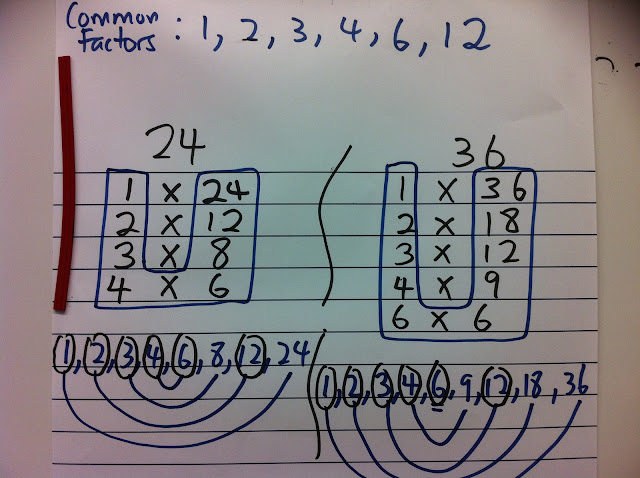General Guide in checking if number 1 to 6 are factors of the given number:
1) Always start with "1" multiplying with the given number itself.
You will notice that "1" and the "given number itself" are always factors of the given number.
2) Check if the next number "2" is a factor of the given number. It will be if the given number is an even number.
3) To check if "3" is a factor of the given number, add all the digits of the given number together.(Rules for divisibility of 3) If they add up to give either 3, 6 or 9, then "3" is a factor of the given number.
Examples
24 ---> 2+4 = 6, hence 3 is definitely a factor of 24
36 ---> 3+6 = 9, hence 3 is definitely a factor of 36
48 ---> 4+8 = 12, continue adding till you come to a single digit number. 1+2 = 3, hence "3" is definitely a factor 48
Counter examples
20 ---> 2+0 = 2, therefore 3 is not a factor of 20
32 ---> 3+2 = 5, therefore 3 is not a factor of 32
59 ---> 5+9 = 14, continue adding till you come to a single digit number. 1+4 = 5, therefore 3 is not a factor of 59
Alternatively, pupils can remember the multiplication tables by hard or to use long division to decide; it will be a factor of the given number if there is no remainder (27 divided by 3 = 9 AND 48 divided by 3 = 16). It is not a factor of the given number if there is remainder (20 divided by 3 = 6 R2 AND 32 divided by 3 = 10 R2)
4) Check if "4" is a factor of the given number. To begin, the given number must be an even number. Every 20s are multiples of 4 (4, 8, 12, 16, 20, 24, 28, 32, 36, 40 ... 60...80... 140 and so on)
Use groups of 20s and number bond to help in deciding.
Examples
20 ---> 4 is definitely a factor of 20
32 ---> use number bond; 32 = 20 + 12. Since 12 can be divided exactly by 4, 4 is a factor of 32.
68 ---> use number bond; 68 = 20 + 20 + 20 + 8. Since 8 can be divided exactly by 4, 4 is a factor of 68.
Counter examples
22 ---> use number bond; 22 = 20 + 2. Since 2 cannot be divided exactly by 4, 4 is not a factor of 22.46 ---> use number bond; 46 = 20 + 20 + 6. Since 6 cannot be dividied exactly by 4, 4 is not a factor of 46.
87 ---> It is not an even number to begin with. Hence 4 is not a factor of 87.
5) Check if "5" is a factor of the given number.
Just look at the digit in the ones place.
5 will only be the factor of the given number if the digit in the ones places is either a "0" or "5".
Examples
20 ---> 5 is a factor of 20.
180 ---> 5 is a factor of 180.
35 ---> 5 is a factor of 35.
265 ---> 5 is a factor of 265.
Counter examples
24 ---> 5 is not a factor of 24.
32 ---> 5 is not a factor of 32.
36 ---> 5 is not a factor of 36.
1039 ---> 5 is not a factor of 1039.
6) Check if "6" is a factor of the given number.
Just check if "2" and "3" are factors of the given number. If they are, "6" will be a factor of the given factor.
Examples
Refer to the pictures, both 2 and 3 are factors of 24 , hence 6 will also be a factor of 24.
Refer to the pictures, both 2 and 3 are factors of 36 , hence 6 will also be a factor of 36.
Counter Examples
Refer to the pictures, 2 is a factor of 20, but not 3. Hence 6 is not a factor of 20.
Refer to the pictures, 2 is a factor of 32, but not 3. Hence 6 is not a factor of 32.
Do try some of these rules on other numbers yourself!
Hope you find them useful!


i have learnt factors...
ReplyDelete